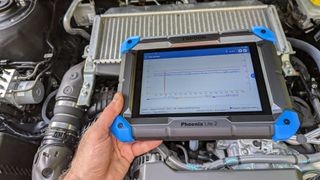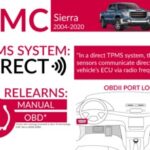The best Touch Screen Obd2 Scanners empower car owners to understand and address vehicle issues without needing a mechanic. These diagnostic tools connect to a car’s onboard computer, providing access to valuable information about its performance and health. A touch screen interface makes navigation and data interpretation easier than ever before. Whether you’re a seasoned mechanic or a DIY enthusiast, a touch screen OBD2 scanner can help you diagnose problems, monitor performance, and keep your car running smoothly.
Top Touch Screen OBD2 Scanner Picks
Based on extensive testing and hands-on experience, we’ve compiled a list of the best touch screen OBD2 scanners available:
1. Topdon Phoenix Lite 2: The Professional’s Choice
The Topdon Phoenix Lite 2 is a powerful and versatile scanner designed for both professionals and serious DIYers. Its rugged design, featuring a large 8-inch touch screen, makes it ideal for use in any environment. This scanner offers a comprehensive suite of diagnostic tests, live data graphing, and advanced features like fault information and predictive analysis. While it requires a subscription after two years, the initial investment provides access to a wealth of information.
2. Launch CR529: Budget-Friendly Powerhouse
Don’t let the affordable price fool you – the Launch CR529 packs a punch. Although it lacks a touch screen, its intuitive interface and color display offer easy navigation. This scanner provides essential features like live data, instant inspection reports, and access to a wide range of diagnostic trouble codes (DTCs). Lifetime updates ensure long-term value and keep your scanner current with evolving automotive technology.
3. Ancel BD310: Dual-Purpose Versatility
The Ancel BD310 stands out with its dual functionality. It serves as a traditional handheld scanner and can also transform into a secondary display for your car’s dashboard, providing real-time engine data. While it has a smaller screen and a minimalist interface, the BD310 offers a convenient and cost-effective solution for diagnosing problems and monitoring performance.
Understanding OBD2 Scanners and DTCs
OBD2 scanners work by communicating with a car’s onboard computer through the OBD2 port, a standardized connector found in most vehicles manufactured after 1996. The scanner retrieves DTCs, which are codes that indicate specific malfunctions detected by the car’s systems.
DTCs consist of a five-character alphanumeric sequence:
- First Character: Indicates the system related to the fault (e.g., P for Powertrain, B for Body, C for Chassis).
- Second Character: Specifies whether the code is generic (0) or manufacturer-specific (1).
- Third Character: Identifies the specific subsystem experiencing the issue (e.g., 1 for Fuel and Air Metering, 3 for Ignition System).
- Fourth and Fifth Characters: Pinpoint the exact fault within the subsystem.
OBD2 scanners not only display DTCs but also provide descriptions of their meaning, enabling users to understand the nature of the problem.
Choosing the Right Touch Screen OBD2 Scanner
When selecting a touch screen OBD2 scanner, consider the following factors:
- Screen Size and Resolution: A larger, high-resolution screen enhances readability and ease of navigation.
- User Interface: An intuitive and responsive touch screen interface simplifies operation.
- Features: Look for features that align with your needs, such as live data graphing, bi-directional controls, and special functions for specific car makes.
- Durability: A rugged design ensures the scanner can withstand the demands of regular use.
- Software Updates: Regular updates are crucial for compatibility with newer vehicle models and access to the latest features.
Investing in a quality touch screen OBD2 scanner can save you time and money on car repairs, giving you the power to diagnose and address issues with confidence.

